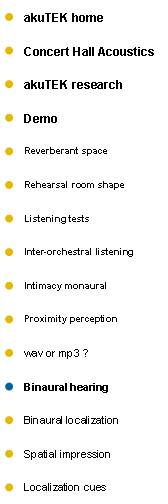



|
akutek.info |
|
The www center for search, research and free sharing in acoustics |

|
Binaural hearing |
|
2014-11-18 Perceptual effects in binaural hearing Binaural hearing in humans have evolved through thousands of generations, making it possible to localize sound sources, to estimate distance to the source, to estimate environment geometry, and to enjoy stereophonic music reproduction—to mention a few. Besides, it has a lot of perceptual side effects. By exposing the two ears separately to different combination of artificial sounds, our minds ability to assign direction, broadness and size, etc, to the sounds, can be demonstrated. In these audio examples, headphones should be used. |
|
Interested in Concert Hall Acoustics?: http://www.akutek.info/concert_hall_acoustics.htm Link to AKUTEK’s Binaural Project site: http://www.akutek.info/binaural_project.htm |
|
on site |
|
# |
Binaural beating |
|
|
1 |
Sine tone 440Hz, both ears, 6 seconds, soft start and stop |
|
|
2 |
Sine tone 440Hz at left, 442Hz at right ear |
|
|
2m |
Like #2, only mono |
|
|
3 |
Sine tone 440Hz at left, 448Hz at right ear |
|
|
3m |
Like #3, only mono |
|
|
Comment: #2 and #3 commonly creates the sensation that the sound travels back and forth between left and right, across the head, with cycles equal to the frequency differences, i.e. 2Hz and 8Hz respectively. Sound pressure differences at the two ears apparently add lateral dimension. In their mono-versions, this does not happen. In real life, an effect similar to #2 and #3 could happen if you face a sinusoidal 440Hz source, having a reflecting wall at your right, while the source moves closer to the wall by 1.5m/s and 6m/s respectively. The image source behind the wall would approach your right ear with these velocities, thus creating 442Hz and 448Hz respectively at your right ear, due to the doppler effect. However, since both ears would receive a mix of the two frequencies, the real life effect would be like a mix of #2 and #2m, or a mix of #3 and #3m. |
||
|
# |
Gradually increasing ITD (lag in channel R), 440Hz sine wave |
|
|
4 |
Reference, lag = 0 samples |
|
|
5 |
Lag = 5 samples ITD=0.11ms |
|
|
6 |
Lag = 10 samples ITD=0.23ms |
|
|
7 |
Lag = 20 samples ITD=0.45ms |
|
|
8 |
Lag = 23 samples ITD=0.52ms |
|
|
9 |
Lag = 30 samples ITD=0.68ms |
|
|
10 |
Lag = 40 samples ITD=0.91ms |
|
|
11 |
Lag = 50 samples ITD=1.1ms |
|
|
12 |
Lag = 60 samples ITD=1.4ms |
|
|
13 |
Lag = 70 samples ITD=1.6ms |
|
|
14 |
Lag = 73 samples ITD=1.7ms |
|
|
15 |
Lag = 80 samples ITD=1.8ms |
|
|
16 |
Lag = 90 samples ITD=2.0ms |
|
|
17 |
Lag = 100 samples ITD=2.3ms |
|
|
18 |
Lag = 110 samples ITD=2.5ms |
|
|
19 |
Lag = 120 samples ITD=2.7ms |
|
|
20 |
Lag = 130 samples ITD=2.9ms |
|
|
21 |
Lag = 140 samples ITD=3.2ms |
|
|
22 |
Lag = 150 samples ITD=3.4ms |
|
|
|
||
|
# |
Lag and inverted phase |
|
|
23 |
Sine tone 440Hz, both ears, 6 seconds, soft start and stop |
|
|
24 |
Like #23, but left channel lagging by half a period (1.14ms or 50 samples) |
|
|
25 |
Like #23, but right channel lagging by half a period |
|
|
26 |
Like #23, but right channel inverted (no lag) |
|
|
Comment: 24, 25 and 26 may be perceived as ”broader” than 23 and with different loudness than 23. The soft (fade-in) start eliminates the transient cue, thus making the half-period lagged examples 24 and 25 and the inverted example 26 hardly distinguishable from one another. Note the brief ”spacious reverb” tails after the ends of 24, 25 and 26. |
||
|
|
|
|
|
Looking for listening tests? |
||
|
Intimacy in monaural perception: |
||
|
Proximity in binaural perception: |
||
|
Hearing others through the orchestra: |
http://akutek.info/demo_files/inter_orchestral_listening.htm |
|
|
|
Headphone test 1, sound in Left channel only: http://akutek.info/wav/sine440HzLeftonly.mp3 Headphone test 2, sound in Right channel only: http://akutek.info/wav/sine440HzRigthonly.mp3 Headphone test 3, sound image should be centered (adjust L-R balance): http://akutek.info/wav/sine440Hz.mp3 |
